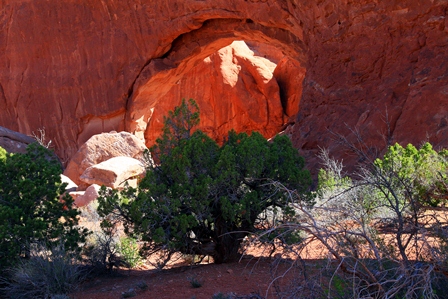North Window Arch Click on image to see more photos |
Arches National Park
Adorning the landscape of eastern Utah’s high desert, Arches National Park is host to the greatest density of natural arches in the world. It is a striking environment of contrasting colors, landforms and textures. Over 2,000 arches exist here, ranging in size from a three-foot opening (the minimum size considered to be an arch); to the world’s most famous arch, Delicate Arch, seen on Utah’s license plate; to the world’s longest natural arch, Landscape Arch, with a span of 290 feet (88 meters).
Other extraordinary features of the park such as towering spires, pillars, fins, columns, balanced rocks, and pinnacles paint an ethereal backdrop to this remarkable collection. Splashes of green contrast with the red sandstone where pinyon and gnarled juniper trees grow. A profusion of wildflowers often grace the landscape from April to July. And though the natural quiet of Arches gives one the impression of lifelessness, many animals can be spotted throughout the park, including mule deer, kit fox, gray fox, jackrabbits and cottontails, coyotes, porcupine, antelope ground squirrels, canyon mice, kangaroo rats and other rodents, as well as plenty of small reptiles. Flocks of blue pinyon jays, ravens, plaintive mourning doves, migratory species such as mountain bluebirds, and even the occasional golden eagle can sometimes be spotted silhouetted against a brilliant sky.
There are a great many recreational activities through which one can appreciate the spectacular scenery, as well as discover the diversity of the natural and historic wonders that comprise Arches National Park. A few of these are: auto touring, backpacking, biking, camping, canoeing, fishing, horseback riding, hiking, a Junior Ranger program for children ages six through eleven, and the visitor center which houses a museum and educational exhibits.
